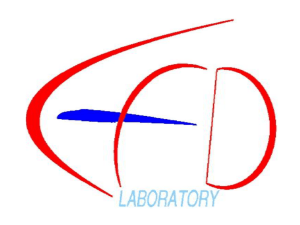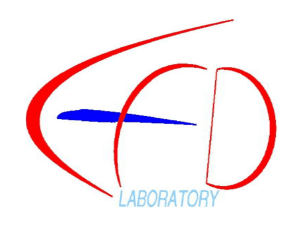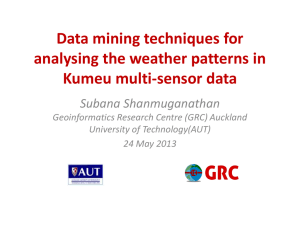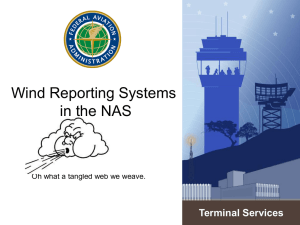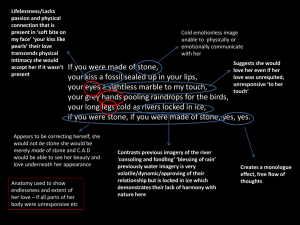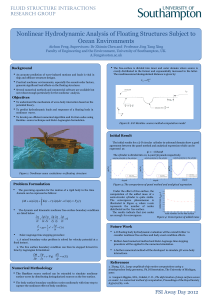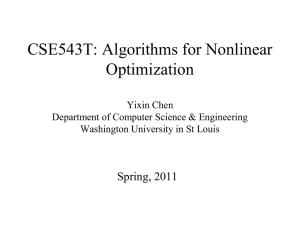Model Reduction for CFD-based Gust Loads Analysis
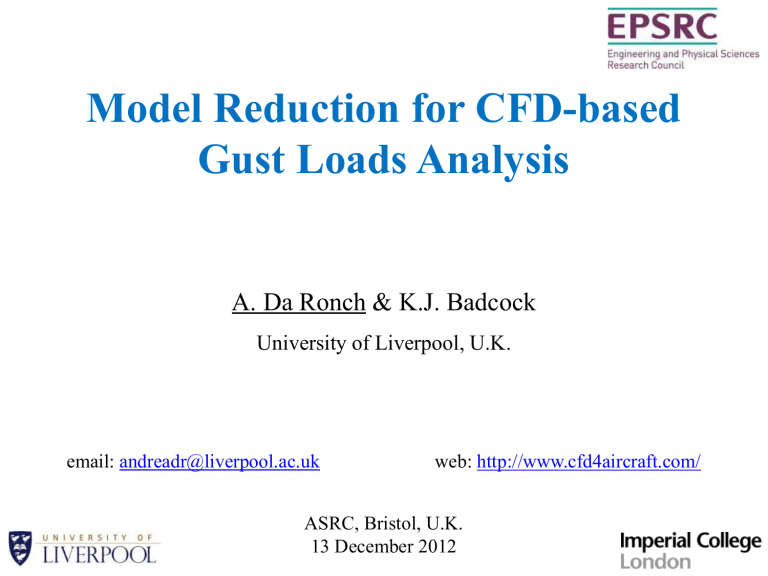
Model Reduction for CFD-based
Gust Loads Analysis
A. Da Ronch & K.J. Badcock
University of Liverpool, U.K.
email: andreadr@liverpool.ac.uk
web: http://www.cfd4aircraft.com/
ASRC, Bristol, U.K.
13 December 2012
Motivation
Physics-based simulation of very flexible aircraft gust interaction
• large amplitude/low frequency modes
• coupled rigid body/structural dynamics
• nonlinearities from structure/fluid (& control)
Nonlinear model reduction for control design
• system identification methods
• manipulation of full order residual
Control design for FCS of flexible aircraft
Testcase
Global Hawk type (DSTL UAV)
• beam/plate FE model of composite material
• control surfaces
• struct model > 1,300 points
•
CFD grid > 6 mio points
- stability augmentation (SAS)
- gust load alleviation (GLA)
- performance optimization
Model Reduction
dw
R
w ,
dt w
w
T f
, w
T s
, w
T r
T
R n
Model Reduction
dw
R
w ,
dt w
w
T f
, w
T s
, w
T r
T
R n w
R n
z
m
C n m
w
z
z
Eigenvalue problem of large order system is difficult
Schur complement
Badcock et al., “Transonic Aeroelastic Simulation for Envelope Searches and Uncertainty
Analysis”, Progress in Aerospace Sciences; 47(5): 392-423, 2011
Model Reduction
dw dt w
w
T f
R
w ,
, w
T s
, w
T r
T
R n w
R n
z
m
C n m
w
z
z
R
w ,
A
w
1
2
B
w ,
w
1
6
C
w ,
w ,
w
R
H.O.T.
2 nd /3 rd Jacobian operators for NROM
Need extended order arithmetics: quad-double precision
Da Ronch et al., “Model Reduction of High-Fidelity Models for Gust Load Alleviation”, AIAA
SDM abstract; 2013
Model Reduction
dw dt w
w
T f
R
w ,
, w
T s
, w
T r
T
R n w
R n
z
m
C n m
w
z
z
R
w ,
A
w
1
2
B
w ,
w
1
6
C
w ,
w ,
w
R
H.O.T.
control surfaces, gust encounter, speed/altitude
How to introduce gust into CFD?
Da Ronch et al., “A New Approach to Computational Fluid Dynamics-Based Gust Loads
Analysis”, AIAA SDM abstract; 2013
Model Reduction
Systematic generation of Linear/Nonlinear ROMs
• independent of large order model
• control design done in the same way dx
dt
Ax
B u u dx
Ax
B u u
dt f nln
Da Ronch et al., “Nonlinear Model Reduction for Flexible Aircraft Control Design”, AIAA
paper 2012-4404; AIAA Atmospheric Flight Mechanics, 2012
Application Examples
1. Pitch-plunge aerofoil with linear aero
• full model reduced model GLA
2. DSTL UAV wing (nonlinear beam with linear aero)
• full model reduced model
GLA
N. Tantaroudas at 15.30 today (Stream A)
3. CFD-based analysis
• pitch-plunge aerofoil
• towards UAV gust simulation (open-, closed-loop)
1. Pitch-Plunge Aerofoil
Structural model: linear/nonlinear
• cubic stiffness in plunge
K=K(1+β
3
ξ 3 )
Aerodynamic model
• flap motion (Wagner)
• gust encounter (Küssner)
Total of 12 states model problem dw
R
w , u c
, u g
dt w w s
w T f
, w T s
T
, h ,
, h
T
3
2
1
Full order model gust response
Gust param:
• “sin”
• h g
• w
0
= 40
= 0.1
Nonlinear:
• β
ξ3
= 3
Nonlinear Full/Reduced order model
Gust param:
• “sin”
• h g
• w
0
= 40
= 0.1
Nonlinear:
• β
ξ3
= 3
Closed-loop gust response
•
H
∞ design for
GLA based on linear ROM
• verification on nonlinear system
•
NROM for nonlinear control?
Papatheou et al., “Active Control for Flutter Suppression: An Experimental Investigation”,
IFASD abstract; 2013
2. DSTL UAV Wing Model
From 2D plate model to 1D beam model
Geometrically-exact nonlinear beam + linear aero
Worst-case gust search
GLA on NROM-based controller N. Tantaroudas at 15.30 today
3. Pitch-Plunge Aerofoil using CFD
Structural model: linear/nonlinear
Aerodynamic model: CFD
• Euler equations
• point distribution, 7974 points
“Heavy” case
Aeroelastic r
α
= 0.539
µ = 100
ω
ξ
/ω
α
= 0.343
Badcock et al., “Hopf Bifurcation Calculations for a Symmetric Airfoil in Transonic Flow”, AIAA
Journal; 42(5): 883-892, 2004
Full/Reduced order model free response
Full model dofs > 32,000
Reduced model dofs = 2
Parameters:
•
U * = 2.0
•
M = 0.6
• α
0
= 1 deg
Full order model free response
Parameter:
• α
0
= 15 deg
•
U * = 2.0
•
M = 0.3
Nonlinear:
• β
ξ3
= 10
Full model dofs > 32,000
Reduced model dofs = 2
Full/Reduced order model gust response
Full model dofs > 32,000
Reduced model dofs = 2
Gust param:
• “1-cos”
• h g
• w
0
= 12.5
= 0.01
Full/Reduced order model gust response
Linear method implemented in TAU DLR code
Gust loads prediction
S. Timme at 15.30 today (Stream B)
Full model dofs > 32,000
Reduced model dofs = 2
Gust param:
• “1-cos”
• h g
• w
0
= 12.5
= 0.01
Fluid-Structure Interface
Interfacing CFD with CSD
• incompatible topology
• transfer forces/displacements between domains
Moving Least Square method
• mesh-free, conservative, linear, ...
Quaranta et al., “A Conservative Mesh-Free Approach for Fluid-Structure Interface
Problems”, Coupled Problems, 2005
Open Source Fighter struct points: 429 fluid points : 32,208
Fluid-Structure Interface
More at http://www.cfd4aircraft.com/research_flexflight_fsi.html
DSTL UAV struct points: 1336 fluid points : 8310
Conclusion
Systematic approach to model reduction
• applicable to any (fluid/structure/flight) systems
• control design done in the same way
Enabling CFD-based analysis for
• gust loads prediction, worst case search, GLA
•
SAS, performance optimization
Next step will be UAV gust analysis with control
gust loads prediction with CFD
S. Timme at 15.30 today
worst case gust search/GLA N. Tantaroudas at 15.30 today email: andreadr@liverpool.ac.uk
web: http://www.cfd4aircraft.com/
